How to start a conservation research project
“The key to this business is personal relationships” This is a quote from fictional character Dicky Fox from the hit movie Jerry McGuire all the way back in 1996, it was true then and it still applies today. Personal relationships are key to conservation, especially when we’re working in a different country. Our lab does not condone parachute science, instead we try to follow a holistic approach that builds genuine relationships with local research institutions and find mutually beneficial arrangements that work for everyone (we’ve published a paper on this). Collaboration, engagement and reciprocity are three of our core values. So, when Dr Michael Grant and I began planning the Borneo river shark project in Kalimantan (Indonesia), we did this together with our local partners at Hasanuddin University in Sulawesi, and we had an MOU in place before we even started looking for funding. To our delight, our Save Our Seas Keystone Grant was successful and things were looking up, and then the COVID-19 pandemic arrived, the world changed, and everything ground to a halt.
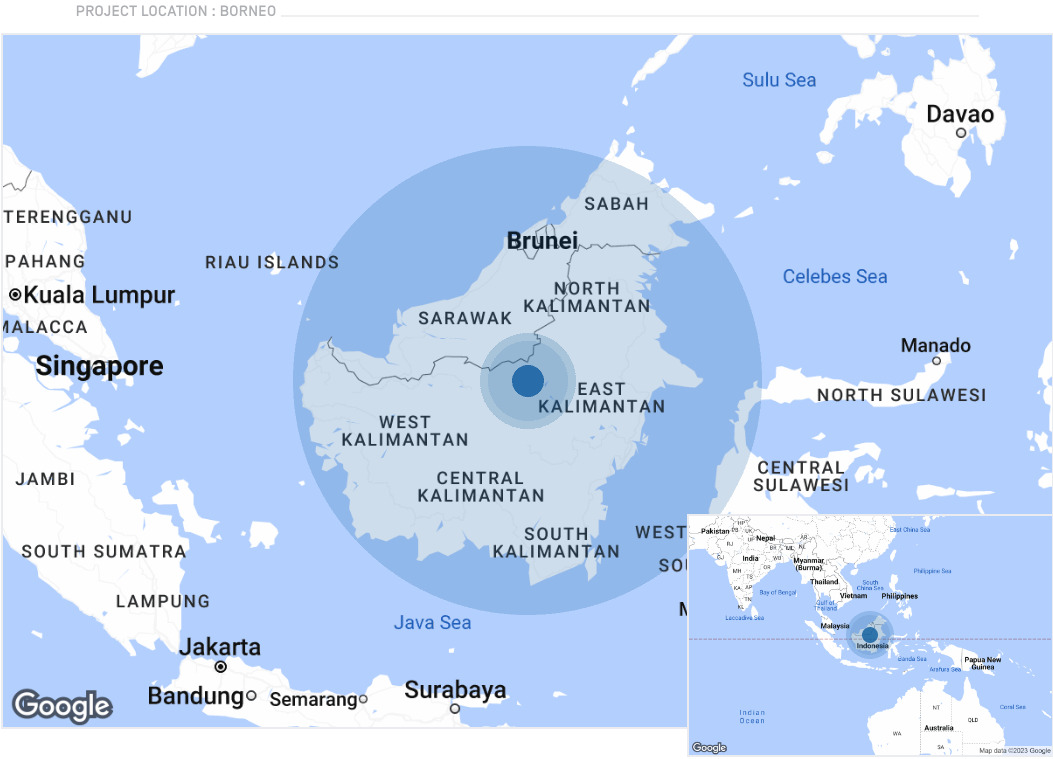
Fast forward two years later, the world is finding its feet in the new normal, travel has restarted, and with the reopening of borders we had the chance to hold our project inception meetings at Hasanuddin University. This was especially important as after two years of COVID, we had to re-establish project relationships and memory, and the project inception meeting was vital for this. What is a project inception meeting? Simply, its when all the project partners get together and meet face-to-face to clarify the project objectives, agree how the project will ‘work’, what everyone’s roles and expectations are, and critically, to actually meet each other and to find out what ‘success looks like’ to all the project partners. These last two are critical to relationship building.
ZOOM/MS Teams/Google Meet have changed the way work happens, but when you’re meeting new people and building new teams, spending time in-person with people is essential. In our field, trust may be hard to come by. Some local people and communities have been treated very poorly be researchers in the past (again, read our paper about this HERE) which make communities and even governments wary and suspicious of foreign researchers. It’s hard to build trust over a computer screen. Indeed, one community elder once told me that “if they (sic. researchers) are really serious about doing the work with us, they need to show up (face to face). We’re not going to work with people we haven’t met.” So even though I personally knew the University Rector and we had existing links with some of the staff, as soon as travel opened, Dr Grant and I booked our tickets for Sulawesi to for a week of meetings at Hasanuddin.
I’d never been to Sulawesi before so I had very open expectations. To summarise, it was great! Hasanuddin University is situated in Makassar, the capital city of Sulawesi and one of the four main cities of Indonesia. Makassar has a long history as an important trading hub, and Makassarese fishermen ventured even as far as Australia. There is very little tourism, we saw only a handful of Caucasians during the entire trip and our Bahasa Indonesia was stretched to the limits at restaurants, but we thoroughly enjoyed the experience. I’ll spare you the hundreds of words I could write about the amazing food.
Three things stand out for me from the trip. Number one, the importance of showing up. I only really began to understand how important this project was to Hasanuddin when I got there. It turns out that our meeting coincided with a visit by a European coral reef research team who were also working in partnership with Hasanuddin, and these projects were ‘headline’ projects for the university to engage in international research. We had a formal meeting with the heads of the university with speeches of welcome and photographs, and there was a very real sense of ceremony. There was a reception at the Rector’s residence (more amazing food), and much discussion about this project being the start of a long-term relationship. None of this would have happened if Dr Grant and I hadn’t taken the time, and budgeted in the cost, of holding inception meetings before the field work began.
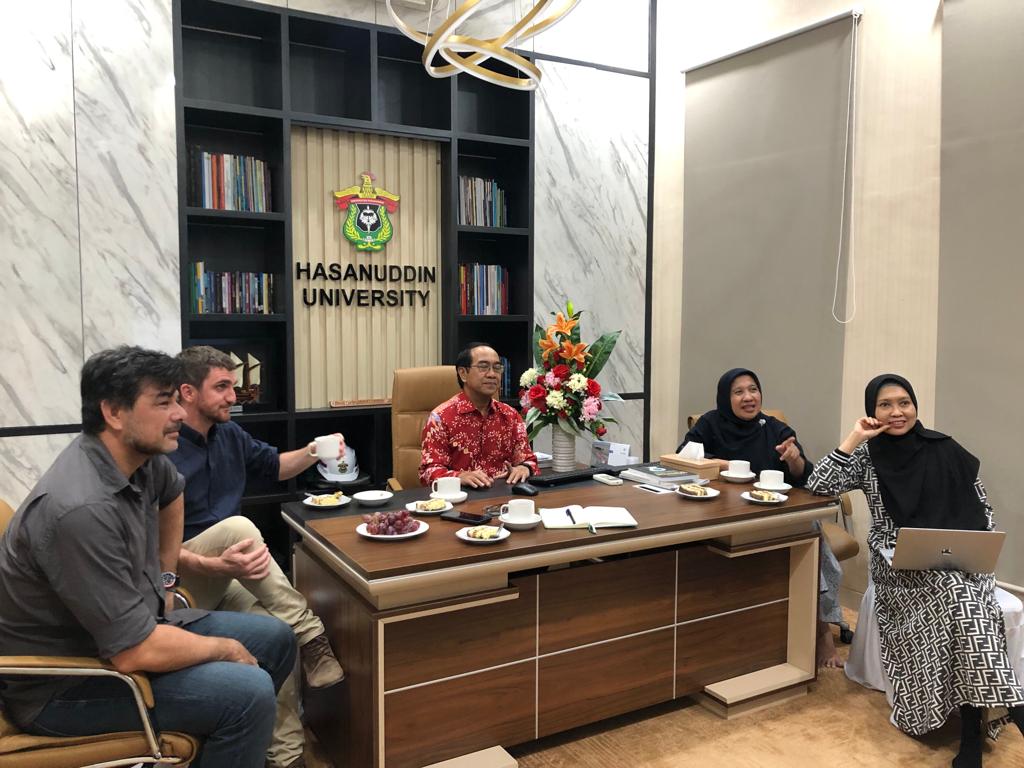
Dr Grant and I meeting with Hasanuddin University Rector Prof Jamaluddin Jompa, and senior staff Prof Rohani Ambo-Rape and A. Prof Nadiarti Nurdin Kadir to talk about the inter-institutional arrangements, scientific goals, and logistics for our SOSF project. Photo by Singgih Putra.
The second thing that struck me is that you can read about a place and do research, but real understanding only comes with time spent on the ground. I knew Hasanuddin was a major university, but it was only when I was physically on the campus that I understood just how big the place is. It is eastern Indonesia’s largest university, and with 37,000 students, has over double the number of students of James Cook University, Plymouth University, or the University of Miami. Hasanuddin is a powerhouse of higher education in eastern Indonesia and it is clear that there is much potential for future collaboration.
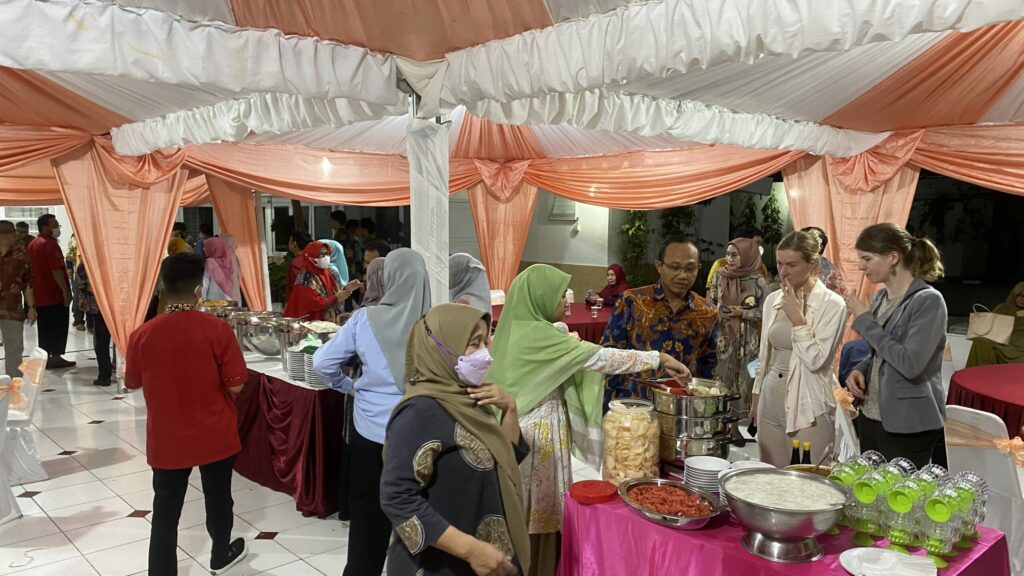
Fantastic hospitality from our partners and hosts at Hasanuddin University where the two research teams were invited to join a function to celebrate the launch of the projects. Photo by Andrew Chin.
The third thing that stands out for me is the simple joy of discovery in going through the local fish markets. Hasanuddin students Singgih Putra and Santia Widyswari took us to two of the local fish markets, explaining the backgrounds for each and helping with translation. What I learnt was that here are different markets for different – well, markets. One market focused on products that were for the everyday community, with a wide range of small pelagic fishes and a few reef species thrown in, seaweeds and invertebrates, while the other market catered towards more wealthy city workers and had larger reef and coastal species. I was pleasantly surprised to see numerous large groupers (Serranidae) and emperors (Lethrinidae) on offer, indicating at first glance that at least there are still large fish to catch and these species are usually the first to be decimated. That said, I have no idea where they came from and it’s clear that fisheries in Sulawesi face the same familiar challenges of overfishing and destructive fishing pressures seen across much of SE Asia. However, there are good projects happening such as local seasonal closures and community-led managed access projects that I hope will become models of good fishery management. Meanwhile, Dr Grant and I were in fish-nerd nirvana, taking photos of everything and asking a million questions. We found a few eagle rays and Dasyatid stingrays, and a few blacktip reef sharks and bamboo sharks (probably Chiloscyllium punctatum), but this is incomparable with places like Muara Angke or Cilacap market on Java where large quantities of sharks and rays are landed (see Alberto BM, White WT, Chin A, Dharmadi, Simpfendorfer CA. 2022. Untangling the Indonesian tangle net fishery: Describing a data-poor fishery targeting large, threatened rays (Superorder Batoidea). Aquatic Conservation: Marine and Freshwater).
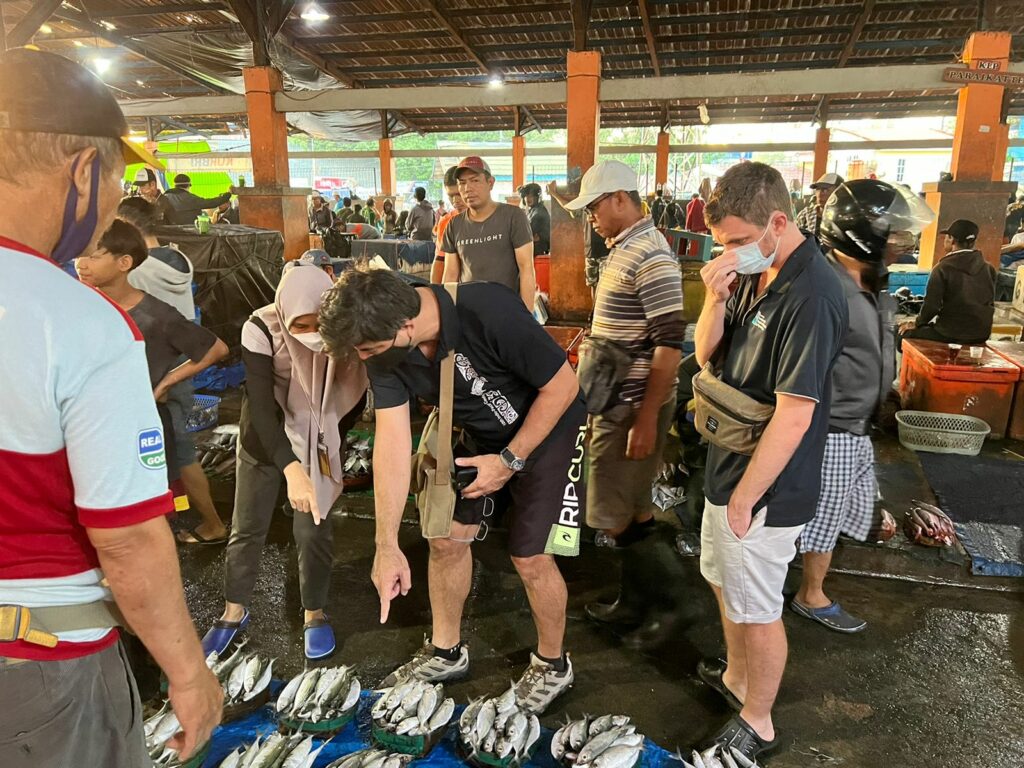
Nerding out at the fish market with UNHAUS postgraduate student and guide Santia. Photo by Singgih Putra
Here, Michal and I found only a handful of sharks and rays, and these were likely taken as bycatch rather than targeted. Aside from the opportunity to explore and let our curiosity roam free across the markets, we wanted to begin to understand how the fish markets ‘work’, which means understanding the peak market times where the most fish are on display, how the markets are arranged, what sort of challenges we might encounter in getting access or recording data. Unlike some other markets I’ve been to, the vendors here were very friendly and open, and curious about us as well. Apparently very few westerners visit these markets which isn’t surprising when you consider that there are very few westerners in the city. It was a great introduction.
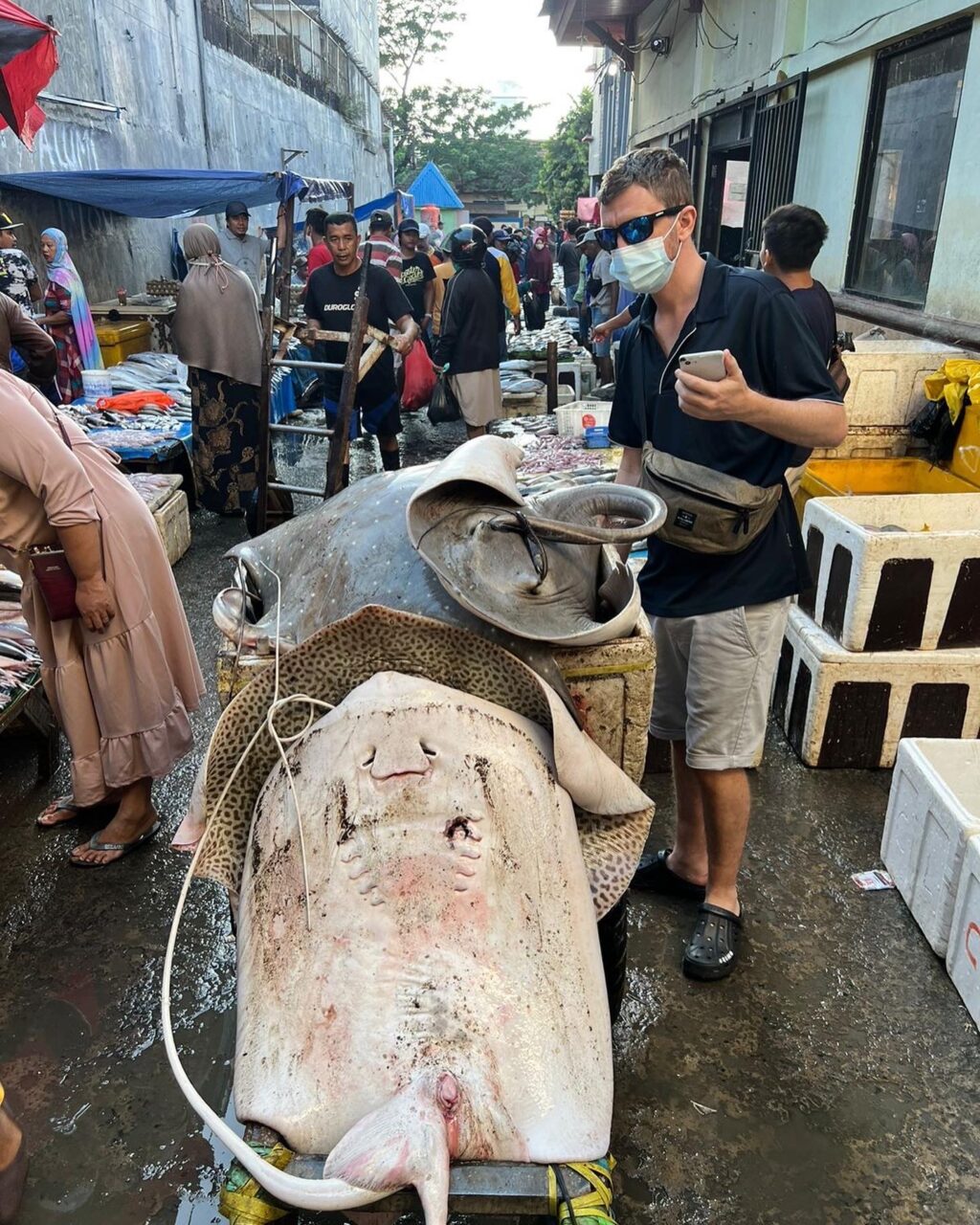
A handful (or cartful of Dasyatid stingrays and eagle rays at the local market. This was a really good opportunity to learn how the markets operate and see what is being landed and sold before the fieldwork actually began. Photo by Andrew Chin.
Overall, the trip was really successful and satisfying. The project got off to a strong start, and our partners at Hasanuddin really want this project to happen. The trip reinforced for me how important it is to show up and build trust and relationships, essential for a complex project like this. You have to show up, find common ground, clarify expectations, and commit to working towards these. This takes time and patience, but for projects like this, I can’t see how you can get long-lasting impact and positive outcomes without it.
As I write this, Dr Grant is currently in the city of Tarakan, North Kalimantan conducting the second trip to look for river sharks and rays and learn about their uses and values to local fishers. It’s been hugely successful so far but I’ll let Michael tell that story in future blogs.
